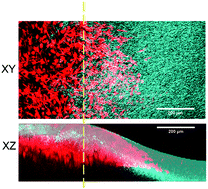Dynamics of 3D carcinoma cell invasion into aligned collagen†
Abstract
Carcinoma cells frequently expand and invade from a confined lesion, or multicellular clusters, into and through the stroma on the path to metastasis, often with an efficiency dictated by the architecture and composition of the microenvironment. Specifically, in desmoplastic carcinomas such as those of the breast, aligned collagen tracks provide contact guidance cues for directed cancer cell invasion. Yet, the evolving dynamics of this process of invasion remains poorly understood, in part due to difficulties in continuously capturing both spatial and temporal heterogeneity and progression to invasion in experimental systems. Therefore, to study the local invasion process from cell dense clusters into aligned collagen architectures found in solid tumors, we developed a novel engineered 3D invasion platform that integrates an aligned collagen matrix with a cell dense tumor-like plug. Using multiphoton microscopy and quantitative analysis of cell motility, we track the invasion of cancer cells from cell-dense bulk clusters into the pre-aligned 3D matrix, and define the temporal evolution of the advancing invasion fronts over several days. This enables us to identify and probe cell dynamics in key regions of interest: behind, at, and beyond the edge of the invading lesion at distinct time points. Analysis of single cell migration identifies significant spatial heterogeneity in migration behavior between cells in the highly cell-dense region behind the leading edge of the invasion front and cells at and beyond the leading edge. Moreover, temporal variations in motility and directionality are also observed between cells within the cell-dense tumor-like plug and the leading invasive edge as its boundary extends into the anisotropic collagen over time. Furthermore, experimental results combined with mathematical modeling demonstrate that in addition to contact guidance, physical crowding of cells is a key regulating factor orchestrating variability in single cell migration during invasion into anisotropic ECM. Thus, our novel platform enables us to capture spatio-temporal dynamics of cell behavior behind, at, and beyond the invasive front and reveals heterogeneous, local interactions that lead to the emergence and maintenance of the advancing front.



 Please wait while we load your content...
Please wait while we load your content...